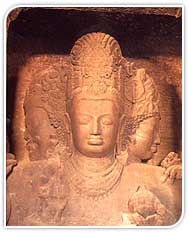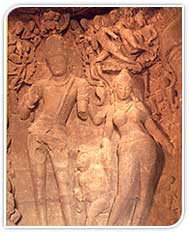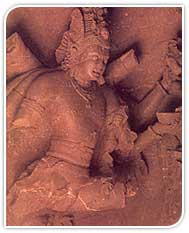 Home
>>States >> Maharashtra
Travel Guide >> Elephanta Travel Guide
Home
>>States >> Maharashtra
Travel Guide >> Elephanta Travel Guide
Elephanta Travel Guide
 Nothing
quite prepare you for the experience that is Elephanta. Even getting there
is different from other trips. The motor launch from Mumbai's Gateway of
India chugs out of the harbour, past fishing boats, large ships and little
islands, buoys bob up and down. The northern coastline of Mumbai. reminds
you of the changing industrial and technological scene. Attendant gulls
hover motionless overhead, an occasional fish leaps out of the wake
furrowing behind it is a pleasant hour and 15 minutes to Elephanta.
Nothing
quite prepare you for the experience that is Elephanta. Even getting there
is different from other trips. The motor launch from Mumbai's Gateway of
India chugs out of the harbour, past fishing boats, large ships and little
islands, buoys bob up and down. The northern coastline of Mumbai. reminds
you of the changing industrial and technological scene. Attendant gulls
hover motionless overhead, an occasional fish leaps out of the wake
furrowing behind it is a pleasant hour and 15 minutes to Elephanta.
The
history of elephanta is the hoary mists of time. Crowning the island's
easteem hill, and commanding a panoramic view of wood-land, marsh and sea,
are the Buddhist stupas' or burial mounds and cisterns. Their antiquity
has been traced back to the third century or even earlier.
Once
known as Puri - later Gharapuri - this island was the proud capital of a
powerful coastal kingdom and the great cave shrine in praise of Shiva,
excavated in the sixth century, added to the ruling dynasty. Several
centuries later the Portugese took possession of the island. They found
monolithic stone elephant at the place where they landed and also named
this a ilha do elephanta, island of the elephant. There was a stone horse
too, a little further, which has a vanished without a trace.

The
Portugese built a fort here with a watchtower, hoisting up to flag to ward
off Aattacks by pirates boats. Did they use the caves for target practice?
Or did they deliberately desecrate the sculptures? Antonio Bocarro,
Portugese chronicler of the 17th century described Elephanta vividity and
made special mention of the cistern of water in the western cave: "There
is also a large and deep tank of water without which the heathens of the
East never build their pagodas; because among their other abominations
they believe that water purifies and cleanses them".
Early
European writes made wild gueses about the origin of the cave, as fanciful
as they were off they mark. One wrote that he had heard it was built by
the Chinese when they were sailing by. Another asserted that it was
Alexander the Great who excavated the cave to the mark of the end of this
conquests. The British followed the Portugese and there are some
interesting 18th century accounts describing Elephanta. Captain Alexander
Hamilton fired a gun into one of the caves,"…I never heard canon
or thunder make such a dreadful noise, which continued for half a minute
and the mountain seemed to shake". As soon as the noise subsided a
serpent 15 ft. long emerged from the cave, sending Alexander Hamilton
pelting down the hill.
 The
great stone elephant toppled over and was earmarking for the British
museum, where it would have been had not the crane broken while attempting
to split it. Jumbo was then moved to a city museum in Mumbai. Out of the
launch you climb 120 steps up a steep hill. Birds and monkeys chatter amid
the branches arching above; though the trees behind you the sea shimmers
in the sunlight as you step into the clearing before the caves. This the,
is Elephanta.
The
great stone elephant toppled over and was earmarking for the British
museum, where it would have been had not the crane broken while attempting
to split it. Jumbo was then moved to a city museum in Mumbai. Out of the
launch you climb 120 steps up a steep hill. Birds and monkeys chatter amid
the branches arching above; though the trees behind you the sea shimmers
in the sunlight as you step into the clearing before the caves. This the,
is Elephanta.
GETTING THERE
Regular launch services
from the gateway of India take you to Elephanta Island throughout the
year, except during the monsoon. If the steep climb up to cave is
daunting, you can hire a chair and be carried up.
THE BEST
TIME TO VISIT
November to March is the ideal time. During May the
crossing may be a little rough.
THE ELEPHANTA FESTIVAL
February sees an explosion of dance and music on the island when the
Elephanta Festival is staged. Eminent artistes- dancers and musicians-
perform under the stars outside the caves. Special launch services take
you to the island and catering arrangements add to your comfort. Plan to
visit Elephanta during Festival time.
Special
Offers on Hotels & Resort Booking in Maharashtra
Travel
Agents & Tour Operators offering Travel Packages to Maharashtra
Nothing quite prepare you for the experience that is Elephanta. Even getting there is different from other trips. The motor launch from Mumbai's Gateway of India chugs out of the harbour, past fishing boats, large ships and little islands, buoys bob up and down. The northern coastline of Mumbai. reminds you of the changing industrial and technological scene. Attendant gulls hover motionless overhead, an occasional fish leaps out of the wake furrowing behind it is a pleasant hour and 15 minutes to Elephanta.
The great stone elephant toppled over and was earmarking for the British museum, where it would have been had not the crane broken while attempting to split it. Jumbo was then moved to a city museum in Mumbai. Out of the launch you climb 120 steps up a steep hill. Birds and monkeys chatter amid the branches arching above; though the trees behind you the sea shimmers in the sunlight as you step into the clearing before the caves. This the, is Elephanta.
